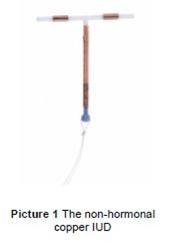Birth Control: Non-Hormonal Copper Intrauterine Device (IUD)

The non-hormonal copper intrauterine device (IUD) (Picture 1) is a small, T-shaped plastic device wrapped in copper with two strings attached. The copper IUD slowly releases copper into the uterus. This keeps sperm from fertilizing an egg. The copper IUD does not have any hormones.
Advantages of the Copper IUD

- more than 99% effective
- lasts up to 10 years
- safe with breastfeeding
- completely reversible
- works right away after it is inserted
- can be used as emergency contraception
- can be put in right after giving birth
Disadvantages of the Copper IUD
- spotting between periods for the first several months (common)
- cramping and some discomfort at the time it is put in
- heavier, longer periods for some people
- more cramps during periods
How It Is Put In
The copper IUD is put into your uterus by a health care provider after a pelvic exam. The IUD is inserted through the opening in your cervix into the uterus. Short strings will hang inside your vagina that you and your health care provider can feel to make sure the IUD is in place. You may feel cramping while it is being put in. Speak with your health care provider about what to do if you have pain.
How It Is Taken Out
Your IUD may be removed at a simple office visit. Your health care provider will put a speculum (the same instrument used for a pelvic exam) inside the vagina to make it easier to see the strings of the IUD. Then they will gently pull the strings to take it out. Taking out the IUD takes less time and is usually less uncomfortable than having it put in. If the IUD strings cannot be seen, or the IUD cannot be taken out in the office, you may need an extra procedure.
Risks
- Perforation: It is rare, but an IUD can be pushed through the wall of the uterus while it is being put in. This is called perforation. Surgery may be needed to remove the IUD if this occurs.
- Expulsion: Sometimes, the IUD can partly or completely slip out of the uterus. This is called expulsion. This is not life threatening, but you can become pregnant if it happens.
- Pregnancy: There is a very small risk of pregnancy with an IUD. This can happen without expulsion happening. If you do become pregnant, there is a higher risk of tubal pregnancy, infection, miscarriage, and early labor and delivery. These problems can be life-threatening. Have the IUD removed if this happens. You can use a condom while having sex to further reduce the chance of pregnancy and sexually transmitted infections.
- Infection: It is very rare, but the IUD can be linked to pelvic inflammatory disease (PID). Most PID happens within 3 weeks of insertion. It is linked to sexually transmitted infections (STIs), like chlamydia or gonorrhea. Infection after 3 weeks is very rare.
Who Cannot Use Them
The non-hormonal copper IUD should not be used by people who:
- have or think they may have a STI or pelvic infection
- have had a pelvic infection in the last 3 months
- have cervical or uterine cancer that has not been treated
- have certain defects of the uterus
- have an allergy to copper
- have Wilson’s Disease
- have unexplained vaginal bleeding that they have not discussed with a health care provider
Tell your health care provider if you have any of these risk factors or conditions, or any other medical concerns.
When to Call the Health Care Provider
Call the doctor or health care provider right away if you:
- think you are pregnant
- think you might have an STI
- have unusual vaginal discharge
- have unexplained fever or chills
- have pain or bleeding with sex
- have unusual or very heavy bleeding from the vagina
- notice any change in the length of the string or can feel part of the IUD
- have unusual pelvic pain, cramping, or soreness in your abdomen (belly)
Preventing STIs
The non-hormonal copper IUD does not protect against sexually transmitted infections (STIs). Condoms are the best way for sexually active people to reduce the risk of infection. Always use a condom when you have sex. Get yearly health check-ups, including testing for STIs.
HH-IV-196 ©2017, revised 2022, Nationwide Children’s Hospital
